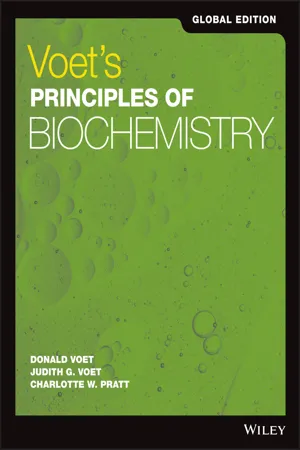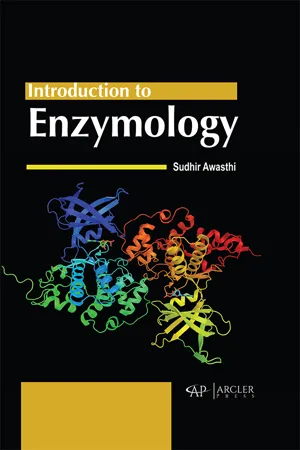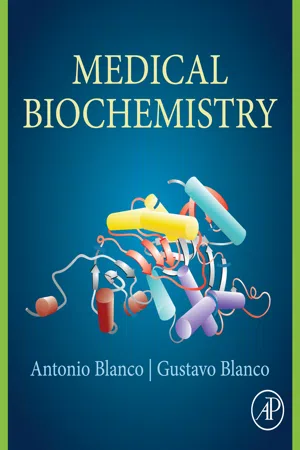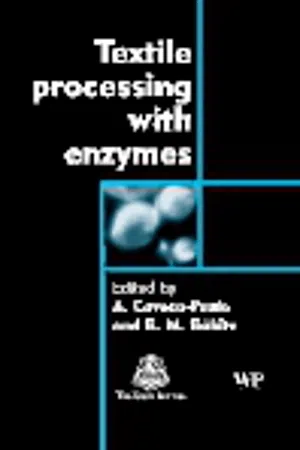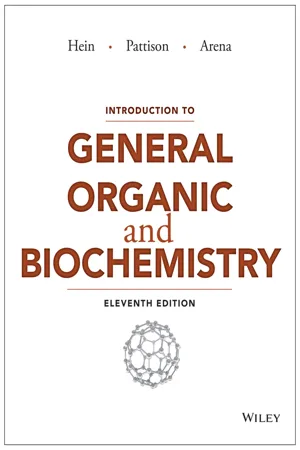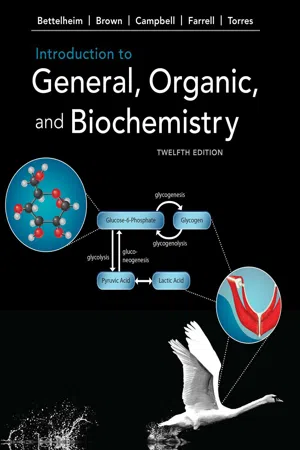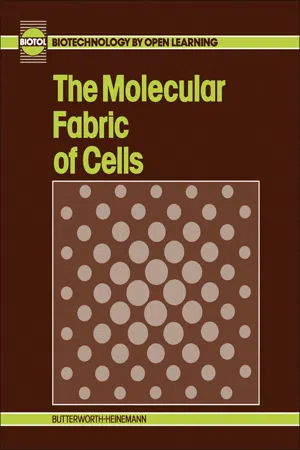Chemistry
Classes of Enzymes
Enzymes are classified into six main classes based on the type of reaction they catalyze: oxidoreductases, transferases, hydrolases, lyases, isomerases, and ligases. Each class of enzymes has specific functions and catalyzes different types of chemical reactions, playing crucial roles in various biological processes.
Written by Perlego with AI-assistance
Related key terms
1 of 5
12 Key excerpts on "Classes of Enzymes"
- eBook - PDF
- Donald Voet, Judith G. Voet, Charlotte W. Pratt(Authors)
- 2018(Publication Date)
- Wiley(Publisher)
and Wolfenden, R., Science 267, 91 (1995). 324 Chapter 11 Mechanisms of Enzyme Action and their products than do chemical catalysts; that is, enzymatic reactions rarely have side products. 4. Capacity for regulation. The catalytic activities of many enzymes vary in response to the concentrations of substances other than their substrates. The mechanisms of these regulatory processes include allosteric control, covalent modification of enzymes, and variation of the amounts of en- zymes synthesized. A Enzymes Are Classified by the Type of Reaction They Catalyze Before delving further into the specific properties of enzymes, a word on nomencla- ture is in order. Enzymes are commonly named by appending the suffix -ase to the name of the enzyme’s substrate or to a phrase describing the enzyme’s catalytic action. Thus, urease catalyzes the hydrolysis of urea, and alcohol dehydrogenase catalyzes the oxidation of primary and secondary alcohols to their corresponding aldehydes and ketones by removing hydrogen. Since there were at first no systematic rules for naming enzymes, this practice occasionally resulted in two different names being used for the same enzyme or, conversely, in the same name being used for two different enzymes. Moreover, many enzymes, such as catalase (which mediates the dismutation of H 2 O 2 to H 2 O and O 2 ), were given names that provide no clue to their function. In an effort to eliminate this confusion and to provide rules for rationally naming the rapidly growing number of newly discovered enzymes, the following scheme for the systematic functional classification and nomenclature of enzymes was adopted by the International Union of Biochemistry and Molecular Biology (IUBMB). Enzymes are classified and named according to the nature of the chemical reac- tions they catalyze. There are six major classes of enzymatic reactions (Table 11-2), as well as subclasses and sub-subclasses. - eBook - PDF
- Khushboo Chaudhary(Author)
- 2023(Publication Date)
- Delve Publishing(Publisher)
CELL ENZYMOLOGY CHAPTER3 1. HISTORY, ENZYME CLASSIFICATION AND NOMENCLATURE Introduction It is the most remarkable and highly specialized protein. Catalyze hundreds of stepwise reactions in biological systems. Regulate many different metabolic activities necessary to sustain life. Living systems use catalysts called enzymes to increase the rate of chemical reactions. The study of enzymes has immense practical importance. In medical science: to know the epidemiology, to diagnose, and to treat diseases (inheritable genetic disorders). • In chemical industries • In food processing • In agriculture • In everyday activities in the home (food preparation, cleaning, beauty care, etc.) Nomenclature of Enzymology The International Enzyme Commission (EC) has recommended a systematic nomenclature for enzymes. This commission assigns names and numbers to enzymes according to the reaction they catalyze. An example of a systematic Cell Technology 164 enzyme name is EC 3.5.1.5 urea aminohydrolases for the enzyme that catalyzes the hydrolysis of urea. The name of an enzyme frequently provides a clue to its function. In some cases, an enzyme is named by incorporating the suffix -ase into the name of its substrate, e.g., pyruvate decarboxylases catalyze the removal of a CO 2 group from pyruvate. Certain protein cutting digestive enzymes are an exception to this general rule of enzyme nomenclature, e.g., pepsin, trypsin, chymotrypsin and thrombin. Isozyme: Within an organism, more than one enzyme may catalyze a given reaction. Multiple enzymes catalyzing the same reaction are called isozymes. Isozymes differ in their catalytic properties. Consequently, the various isozymes that are present in different tissues or at different developmental stages can carry out slightly different metabolic functions. Pyruvate Decarboxylase Alanine Aminotransferase Enzyme Classification Class of Enzyme 1. Oxidoreductases: Oxidation-reduction reactions 2. Transferases: Transfer of functional groups 3. - eBook - PDF
- Sudheer Awasthi(Author)
- 2023(Publication Date)
- Arcler Press(Publisher)
The Enzyme Commission established six broad classifications of reactions, with each enzyme falling into one of the six categories (Worsfold, 1995). Classifications and Modifications of Enzymes 51 Figure 2.5. According to the EC classification, enzymes are divided into six different classes. Source: Data from BRENDA database (January 2009 release) The figure shown above depicts enzymes from all of these 6 classes (BRENDA information release January 2009). The most common enzymes are those involved in redox and hydrolytic reactions, as one might expect. The 6 six classes are (Thompson, 1962): 1. Oxidoreductases 2. Hydrolases 3. Transferases 4. Isomerases 5. Lyases 6. Ligases According to the type of the catalyzed reaction, all of these 6 classes are further split into various subclasses and sub-subclasses. Every enzyme is assigned a code number based on a 4-number system in this classification. The 1 st number in this system denotes the core class, while the 2 nd and 3 rd numbers denote the subclass and sub-subclass, defining the reaction type. The 4 th digit is the enzyme’s actual number within its sub-subclass (McDonald & Tipton, 2014). Alcohol dehydrogenase, for instance, has the code “EC 1.1.1.1.” It belongs to the oxidoreductase class, as indicated by the 1 st number (EC 1.a.a.a). Enzymes that act on the methylene-hydroxyl group Introduction to Enzymology 52 of donors are assigned the exact same subclass number within this class (EC 1.1.a.a). The number EC 1.1.1.a is assigned to enzymes that utilize NAD or NADP as an electron acceptor. Because alcohol dehydrogenase is the 1 st enzyme in this group, it receives the number four (EC 1.1.1.1). Likewise, the first three digits of the EC code of all carboxylesterases are the same (EC 3.1.1.a). The 4 th digit, on the other hand, indicates which carboxylic ester they hydrolyze (Aszalos, 1978). - eBook - PDF
- Donald Voet, Charlotte W. Pratt, Judith G. Voet(Authors)
- 2014(Publication Date)
- Wiley(Publisher)
Enzymes are classified and named according to the nature of the chemical reactions they catalyze. There are six major classes of enzymatic reactions (Table 11-2), as well as subclasses and sub-subclasses. Each enzyme is assigned two names and a four-part classification number. Its accepted or recommended name is convenient for everyday use and is often an enzyme’s previously used name. Its systematic name is used when ambiguity must be minimized; it is the name of its substrate(s) followed by a word ending in -ase specifying the type of reaction the enzyme catalyzes according to its major group classification. For example, the enzyme whose alternative name is aconitase (Section 17-3B) has the systematic name aconitate hydratase and the classification number EC 4.2.1.3 (“EC” stands for Enzyme Commission, and the numbers represent the class, subclass, sub-subclass, and an arbitrarily assigned serial number in the sub- subclass). For our purposes, the recommended name of an enzyme is usually ad- equate. However, EC classification numbers are increasingly used in various Internet-accessible databases (Section 14-4C). Systematic names and EC classi- fication numbers can be obtained via the Internet (http://expasy.org/enzyme/). B Enzymes Act on Specific Substrates The noncovalent forces through which substrates and other molecules bind to enzymes are similar in character to the forces that dictate the conformations of the proteins themselves (Section 6-4A). Both involve van der Waals, elec- trostatic, hydrogen bonding, and hydrophobic interactions. In general, a substrate-binding site consists of an indentation or cleft on the surface of an enzyme molecule that is complementary in shape to the substrate (geometric complementarity). Moreover, the amino acid residues that form the binding site are arranged to specifically attract the substrate (electronic complemen- tarity, Fig. 11-1). - eBook - PDF
- Khushboo Chaudhary, Pankaj Kumar Saraswat(Authors)
- 2023(Publication Date)
- Delve Publishing(Publisher)
ENZYMOLOGY CHAPTER2 12. INTRODUCTION: REVIEW OF A BRIEF HISTORY, ENZYMES AS BIOLOGICAL CATALYSTS, CLASSIFICATION, NOMENCLATURE, PROXIMITY AND ORIENTATION, COVALENT CATALYSIS, ACID-BASE CATALYSIS. Introduction It is the most remarkable and highly specialized protein. Catalyze hundreds of stepwise reactions in biological systems. Regulate many different metabolic activities necessary to sustain life. Living systems use catalysts called enzymes to increase the rate of chemical reactions. The study of enzymes has immense practical importance. In medical science: to know the epidemiology, to diagnose, and to treat diseases (inheritable genetic disorders). • In chemical industries • In food processing • In agriculture • In everyday activities in the home (food preparation, cleaning, beauty care ,etc.) Basic Biology 94 Nomenclature of Enzymology The International Enzyme Commission (EC) has recommended a systematic nomenclature for enzymes. This commission assigns names and numbers to enzymes according to the reaction they catalyze. An example of a systematic enzyme name is EC 3.5.1.5 urea aminohydrolases for the enzyme that catalyzes the hydrolysis of urea. The name of an enzyme frequently provides a clue to its function. In some cases, an enzyme is named by incorporating the suffix -ase into the name of its substrate, e.g., pyruvate decarboxylases catalyzes the removal of a CO 2 group from pyruvate. Certain protein cutting digestive enzymes are an exception to this general rule of enzyme nomenclature, e.g., pepsin, trypsin, chymotrypsin and thrombin. Isozyme:Within an organism, more than one enzyme may catalyze a given reaction. Multiple enzymes catalyzing the same reaction is called isozymes (Scribd, slideshare, molecular-plant-biotechnology, slideplayer, documents, docplayer, bmb.psu, powershow, bioscience, docslide, msluay, scienceprofonlue, biotechuniverse.blogspot). - No longer available |Learn more
- Gustavo Blanco, Antonio Blanco(Authors)
- 2017(Publication Date)
- Academic Press(Publisher)
e ) (see p. 152). Enzymes are more effective than most inorganic catalysts; moreover, enzymes show a greater specificity of effect. Usually inorganic catalysts function by accelerating a variety of chemical reactions, whereas enzymes catalyze only a specific chemical reaction. Some enzymes act on different substances, but generally, these are compounds with similar structural characteristics and the catalyzed reaction is always of the same type.The substances that are modified by enzymes are called substrates .The specificity of enzymes allows them to have high selectivity to distinguish among different substances and even between optical isomers of a compound. For example, glucokinase, an enzyme that catalyzes d -glucose phosphorylation, does not act on l -glucose.Nomenclature and classification of enzymes
Enzymes are often named by adding the suffix -ase to the name of the substrate that they modify. For example, amylase, urease, and tyrosinase are enzymes that catalyze reactions involving starch, urea, and tyrosine, respectively. Enzymes are also designated by the type of reaction catalyzed, for example, dehydrogenases and decarboxylases catalyze hydrogen and carboxyl removal from different substrates, respectively.Certain enzymes have arbitrary names; among them are saliva ptyalin, gastric pepsin, and pancreatic trypsin and chymotrypsin.The confusion created by the use of names according to different criteria, led the International Union of Biochemistry and Molecular Biology (IUBMB) to propose a classification system, to assign each enzyme a descriptive name and a number that allows its unequivocal identification. In this classification, six main Classes of Enzymes are considered according to the type of reaction catalyzed. Each class is divided into subclasses and sub-subclasses. The numeric code used to identify the enzyme consists of four components: the first number corresponds to the main enzyme class, the second refers to the subclass, the third denotes the sub-subclass (these numbers are assigned taking into account the nature of the atom groups involved in the reaction), and the fourth represents the enzyme order number in its sub-subclass. Periodically the IUBMB publishes the nomenclature of enzymes giving their systematic name, type of substrates used, and reaction catalyzed; the common or recommended trivial name and the code number is also indicated. To accurately identify an enzyme, the code number must be mentioned. In this book, the trivial name recommended by the IUBMB will be used, except for cases, in which the use has imposed another denomination. - eBook - PDF
- A Cavaco-Paulo, G Gubitz(Authors)
- 2003(Publication Date)
- Woodhead Publishing(Publisher)
Some enzymes require small non-protein molecules, known as cofac-tors, in order to function as catalysts. Enzymes differ from chemical catalysts in several important ways: 1. Enzyme-catalysed reactions are at least several orders of magnitude faster than chemically-catalysed reactions. When compared to the 1 corresponding uncatalysed reactions, enzymes typically enhance the rates by 10 6 to 10 13 times. 2. Enzymes have far greater reaction specificity than chemically-catalysed reactions and they rarely form byproducts. 3. Enzymes catalyse reactions under comparatively mild reaction con-ditions, such as temperatures below 100°C, atmospheric pressure and pH around neutral. Conversely, high temperatures and pressures and extremes of pH are often necessary in chemical catalysis. 1.1.1 In this chapter This chapter is concerned mainy with the fundamental aspects of enzymes that determine their properties and catalytic capabilities. It is intended to provide a sound basis for understanding of many of the applied aspects of enzymes considered in subsequent chapters in this text. Given the wealth of fundamental knowledge on enzymes, it is only possible here to provide a perspective on each of the topics. Some of the topics will be considered in more detail, or from a different perspective, later on in the text. Section 1.2 deals with the classification and nomenclature of enzymes. It considers some of the rules that form the basis of a rational system classi-fication and naming enzymes, and provides examples of enzymes in each of the six main classes. Much of the chapter is devoted to protein structure (Section 1.3) because this ultimately defines the properties of enzymes, such as substrate specificity, stability, catalysis and response to physical and chemical factors. - eBook - PDF
Chemistry for Today
General, Organic, and Biochemistry
- Spencer Seager, Michael Slabaugh, Maren Hansen, , Spencer Seager, Spencer Seager, Michael Slabaugh, Maren Hansen(Authors)
- 2021(Publication Date)
- Cengage Learning EMEA(Publisher)
20.1C Regulation A third significant property of enzymes is that their catalytic behavior can be regulated. Even though each living cell contains thousands of different molecules that could react with each other in an almost unlimited number of ways, only a relatively small number of these possible reactions take place because of the enzymes present. The cell controls the rates of these reactions and the amount of any given product formed by regulating the action of the enzymes. 20.2 Enzyme Nomenclature and Classification Learning Objective 2 Determine the function and/or substrate of an enzyme on the basis of its name. Some of the earliest discovered enzymes were given names ending with -in to indicate their protein composition. For example, three of the digestive enzymes that catalyze pro- tein hydrolysis are named pepsin, trypsin, and chymotrypsin. The large number of enzymes now known has made it desirable to adopt a system- atic nomenclature system known as the Enzyme Commission (EC) system. Enzymes are grouped into six major classes on the basis of the reaction catalyzed (see Table 20.1). In the EC system, each enzyme has an unambiguous (and often long) systematic name that specifies the substrate (substance acted on), the functional group acted on, and the type absolute specificity The characteristic of an enzyme that it acts on one and only one substance. relative specificity The characteristic of an enzyme that it acts on several structurally related substances. stereochemical specificity The characteristic of an enzyme that it is able to distinguish between stereoisomers. substrate The substance that undergoes a chemical change catalyzed by an enzyme. even the particular substance that will be involved in the reaction. For example, strong acids catalyze the hydrolysis of any amide, the dehydration of any alcohol, and a variety of other processes. - Morris Hein, Scott Pattison, Susan Arena, Leo R. Best(Authors)
- 2014(Publication Date)
- Wiley(Publisher)
MR.BIGPHOTOGRAPHY/iStockphoto C H A P T E R 30 30.1 Molecular Accelerators 30.2 Rates of Chemical Reactions 30.3 Enzyme Kinetics 30.4 Industrial-Strength Enzymes 30.5 Enzyme Active Site 30.6 Temperature and pH Effects on Enzyme Catalysis 30.7 Enzyme Regulation ENZYMES C H A P T E R O U T L I N E P erhaps you have seen laundry detergents advertised as “containing enzymes.” Enzymes are added to detergents to clean especially hard-to-remove spots. In living organisms, enzymes also take on the “tough” metabolic tasks—in fact, life cannot continue in the absence of enzymes. Enzymes are important because they can accelerate a chemical reaction by 1 million to 100 million times. Imagine what would happen if some of our tasks were accelerated by that amount! A two-hour daily homework assignment would be completed in about one-thousandth of a second. A flight from Los Angeles to New York would take about one-hundredth of a second. The building of Hoover Dam, a monumental task requiring five years of earthmoving and complex steel and concrete work, would occur in about 30 seconds. Scientists now understand the general characteristics of enzymes. And, as we will see in this chapter, these molecules achieve almost miraculous results by following some very basic chemical principles. All the energy expended by this weight lifter comes from enzyme-catalyzed reactions. 30.1 • Molecular Accelerators 797 30.1 MOLECULAR ACCELERATORS Describe the six main Classes of Enzymes and define the terms apoenzyme, coenzyme, and holoenzyme. Enzymes are proteins that catalyze biochemical reactions. Enzymes catalyze nearly all the myriad reactions that occur in living cells. Uncatalyzed reactions that require hours of boiling in the presence of a strong acid or a strong base in the laboratory can occur in a fraction of a second in the presence of the proper enzyme at room temperature and nearly neutral pH.- Frederick Bettelheim, William Brown, Mary Campbell, Shawn Farrell(Authors)
- 2019(Publication Date)
- Cengage Learning EMEA(Publisher)
641 CONTENTS 22.1 Enzymes are Biological Catalysts 22.2 Enzyme Nomenclature 22.3 Enzyme Activity 22.4 Enzyme Mechanisms 22.5 Enzyme Regulation 22.6 Enzymes in Medicine Enzymes 22 22.1 Enzymes are Biological Catalysts The cells in your body are chemical factories. Only a few of the thousands of compounds necessary for the human organism are obtained from the diet. Instead, most of these substances are synthesized within the cells, which means that thousands of chemical reactions take place in your cells every second of your life. Nearly all of these reactions are catalyzed by enzymes , which are large molecules that increase the rates of chemical reactions without themselves undergoing any change. Without enzymes to act as biological catalysts, life as we know it would not be possible. The vast majority of all known enzymes are globular proteins, and we will devote most of our study to protein-based enzymes. However, pro-teins are not the only biological catalysts. Ribozymes are enzymes made of ribonucleic acids. They catalyze the self-cleavage of certain portions of their own molecules and are involved in the reaction that generates pep-tide bonds (Chapter 21). Many biochemists believe that during evolution, RNA catalysts emerged first, with protein enzymes arriving on the scene later. (We will learn more about RNA catalysts in Section 24.4.) Like all catalysts, enzymes do not change the position of equilibrium. That is, enzymes cannot make a reaction take place that would not occur without them. Instead, they increase the reaction rate: they cause reactions © ibreakstock/Shutterstock.com Ribbon diagram of cytochrome c oxidase, the enzyme that directly uses oxygen during respiration. Copyright 2020 Cengage Learning. All Rights Reserved. May not be copied, scanned, or duplicated, in whole or in part. Due to electronic rights, some third party content may be suppressed from the eBook and/or eChapter(s).- eBook - PDF
- Commission on Biochemical Commission on Biochemical Nome, Commission on Biochemical Nome(Authors)
- 2012(Publication Date)
- Academic Press(Publisher)
Others are mainly historical, e.g. acid and alkaline phosphatase. A third general principle adopted is that the enzymes are divided into groups on the basis of the type of reaction catalysed, and this, together with the name(s) of the substrate(s) provides a basis for naming individual enzymes. It is also the basis for classification and code numbers. Special problems attend the classification and naming of enzymes catalysing complicated transformations that can be resolved into several sequential or coupled intermediary reactions of different types, all catalysed by a single enzyme (not an enzyme system). Some of the steps may be spontaneous non-catalytic reactions, while one or more intermediate steps depend on catalysis by the enzyme. Wherever the nature and sequence of intermediary reactions is known or can be presumed with confidence, classification and naming of the enzyme should be based on the first enzyme-catalysed step, that is essential to the subsequent transformations, which can be indicated by a supplementary term in parentheses, e.g. L-malate glyoxylate-lyase (CoA-acetylating) (EC 4.1.3.2, cf. section 3). For the classification according to the type of reaction catalysed, it is occasionally necessary to choose between alternative ways of regarding a given reaction. Some considerations of this type are outlined in section 3 of this chapter. In general, that alternative should be selected which fits in best with the general system of classification and reduces the number of exceptions. One important extension of this principle is the question of the direction in which the reaction is written for the purposes of classification. To simplify the classification, the direction chosen should be the same for all enzymes in a given class, even if this direction has not been demonstrated for all. - eBook - PDF
- BIOTOL, B C Currell, R C E Dam-Mieras(Authors)
- 2013(Publication Date)
- Butterworth-Heinemann(Publisher)
250 Chapter 8 8.12 Enzyme technology The study of enzymes has been of immense importance in increasing our understanding of how living organisms operate at the molecular level. The knowledge obtained has also been of value in discovering the molecular basis of many illnesses and has been used in both diagnosis and treatment of illness and in the design of drugs. Along with understanding of the structure, role and properties of enzymes has come the realisation that these remarkable catalysts could have a role in technology: that their catalytic capabilities could be used to achieve desired objectives. The purpose of this section is to briefly review some of the uses that have been made of enzymes; these are collectively described as enzyme technology. We have already identified the factors which make enzymes attractive for technological purposes. These are: • specificity -both in terms of substrate and the reaction performed; • high catalytic rates; • frequently, use of mild reaction conditions; • ability to be controlled -reaction can be stopped by changing the pH or temperature; • wide range of reactions catalysed. The use of enzymes as industrial/commercial catalysts is discussed in detail elsewhere in this series (Technological Applications of Biocatalysts). Operational areas are summarised in Table 8.6. Area Food industry Pharmaceutical industry Detergents Analytical Medical Environmental Textiles Use of Enzymes/Product Amino acids/high fructose syrup, baking, brewing, wine industries. Production of semi-synthetic penicillins. Transformation of steroids. Use of proteases and amylases Glucose estimation. Detection of toxins. Diagnostic use; biosensors. Detoxication Desizing Table 8.6 Applications of enzymes in industry. Note that before any of these applications could be commercialised, it was necessary to isolate, purify, characterise and develop the relevant enzyme.
Index pages curate the most relevant extracts from our library of academic textbooks. They’ve been created using an in-house natural language model (NLM), each adding context and meaning to key research topics.
